
Hello friends Lakshmi,how are you today? hope fully fine..
Pumpkin Leaf-Eating Beetles: A Threat to Agriculture
Small beetles that eat pumpkin leaves (genus: Diabrotica spp.) are one of the main pests that often attack pumpkin plants in various parts of the world. Despite their small size, these pests can cause significant damage to crops, threatening crop yields and farmer well-being.
Identification and Life Cycle
This beetle has a body color that is generally yellowish green with black stripes, although color variations can occur. They are usually found in warm, temperate areas, where pumpkins grow abundantly. The life cycle of this beetle includes egg, larva, pupa and adult. The eggs are laid near the roots of the plant, and once they hatch, the larvae begin to gnaw at the roots and even eat the young roots of the plant.
Impact on Pumpkin Plants
These beetles specifically target plants in the Cucurbitaceae family, including pumpkins, watermelons and cucumbers. The initial attack usually occurs in the young growth stages of the plant, when the larvae destroy the root system. In the next stage, the adult beetles will eat the leaves of the plant, causing holes in the leaves and potentially affecting photosynthesis and the plant's ability to grow properly.

Control Methods
Control of pumpkin leaf-eating ladybugs can be done in several ways:
Cultural Control: Agricultural practices such as crop rotation, timing of planting, and regular monitoring can help reduce beetle populations.
Biological Control: The use of natural predators or parasitoids that prey on beetles or their larvae can be an effective solution without damaging the environment.
Chemical Control: Careful use of recommended insecticides can also control beetle populations, but must be done wisely so as not to damage the environment and human health.
Economic and Environmental Implications
This beetle attack not only reduces pumpkin yields, but can also increase production costs for farmers due to the need for intensive control measures. In addition, the use of chemical insecticides in large quantities can have a negative impact on the environment and human health.
Conclusion
Pumpkin leaf-eating ladybugs are a serious threat to agriculture in many regions. By developing sustainable and effective control strategies, and increasing awareness of the importance of pest management, we can help protect pumpkin crops from damage caused by these pests, maintain agricultural productivity, and support overall agricultural environmental sustainability.
Greeting to everyone..
Thank you, friend!


I'm @steem.history, who is steem witness.
Thank you for witnessvoting for me.
please click it!
(Go to https://steemit.com/~witnesses and type fbslo at the bottom of the page)
The weight is reduced because of the lack of Voting Power. If you vote for me as a witness, you can get my little vote.
Downvoting a post can decrease pending rewards and make it less visible. Common reasons:
Submit
Downvoting a post can decrease pending rewards and make it less visible. Common reasons:
Submit
Upvoted. Thank You for sending some of your rewards to @null. It will make Steem stronger.
Downvoting a post can decrease pending rewards and make it less visible. Common reasons:
Submit